Wil reviews the all-new 2021 Specialized Epic
Originally launched back in 2002, the Specialized Epic debuted as the very first full suspension bike on the market to feature a fully automated lockout system. That early Epic (and every model since) was built around the Brain – an inertia-valve shock damper that could transition from fully locked out, to fully open whenever the rider hit something hard enough. Mike McAndrews, the director of suspension technology at Specialized, came up with the concept as a way to woo racers off of their hardtails. With its unique ability to remain locked out while sprinting, the Epic did the trick, and it’s remained as the brand’s flagship XC race bike ever since.
XC racing has of course progressed significantly over the past two decades, and so too has the Epic. For 2021, Specialized is launching an entirely new Epic and Epic EVO, and both represent a stunning leap forward in terms of suspension performance, geometry and handling. To get a deeper understanding of all the changes and how they play out on the trail, we’ve had both the Epic and Epic EVO on test for the past month. For more info about the EVO, check out the full review here. Right now though, we’re going to dive straight into the new Epic – one of the lightest, fastest and most efficient XC race bikes we’ve ever tested.
Watch our video review of the new 2021 Specialized Epic & Epic EVO here!


Specialized Epic Overview
Admittedly the new Epic doesn’t look all that different from its predecessor, and indeed it remains as a 100mm travel XC race bike built around 29in wheels and a full carbon chassis. The general suspension layout carries over, and so too does the dual-bottle capability (only the XS size is limited to fitting a single bottle inside the mainframe).
Make no mistake though, because the frame is brand-spanking new. The big improvement is lateral stiffness through the swingarm, which is purportedly up by 15%. Specialized also claims that side-loading on the rear shock has also been reduced by 30%, which in theory will help with both suspension performance and shock durability.
Despite the stiffness increase, Specialized’s engineers have managed to chisel off 100g over the old frame.
It’s the lightest Epic yet
Despite the stiffness increase, Specialized’s engineers have managed to chisel off 100g over the old frame. The S-Works Epic, which is built from FACT 12m carbon fibre, is claimed to weigh just 1,869g (medium size, including shock, thru-axle, hanger and hardware). The weight drop hasn’t come from any one place in particular, though most savings were found in the back end. The seatsays are notably slimmer, and the rocker link is now made from compression-moulded carbon fibre. Instead of cartridge bearings, the seatstay pivots now rotate on IGUS bushings, which are lighter and more resistant to lateral loads.

All other Epic models use a slightly cheaper FACT 11m carbon frame along with an alloy rocker link. There’s only a very small weight penalty though – claimed weight is still under the 2kg barrier at 1,947g.
Specialized hasn’t pursued weight at the expense of serviceability though. You’ll still find a standard threaded BB shell, drop-in headset bearings and a tidy 148x12mm thru-axle. A nice touch is that the main pivot is keyed into the frame, so you only need to tighten it from one side. The Epic is also the first model from Specialized to feature the SRAM Universal Derailleur Hanger (UDH), which we’re thrilled to see is being picked up by more brands.
The only thing we’d like to see on this frame is a steering limiter of some sort (like Canyon’s IPU headset, or the downtube protector Specialized used on the previous generation Epic HT). As it stands, the top tube is very much in the firing line of the shifter and brake levers in the event of a wheel-twisting crash. This may not be an issue on all frame sizes and all rider’s setups, but it is on our medium test bike. I can only imagine the tears I would cry if I were to scratch this lovely frame.
Instead of cartridge bearings, the seatstay pivot now rotates on IGUS bushings, which are lighter and more resistant to lateral loads.
A new Brain & shock
Likewise the rear shock may look the same, but it too is all-new. The goal here was to improve performance and durability, while reducing maintenance. To that end the shock now features a hardened chrome steel damper shaft that’s supported with dual bushings, while the air sleeve also gets widened dual bushings around the main seal. It does mean that the shock is a little heavier than before, but the overall structure is significantly stiffer and stronger.

Specialized says it doesn’t need as much servicing either – recommended intervals are 125-hours for an air sleeve service, and an impressive 250-hours for a damper service. What’s really neat is that owners of a new Epic will have 2-years of shock servicing included, providing they register their bike online. Key dealers will even have loaner shocks available.
Additionally, the new shock is more tuneable than before. It comes fitted with a single volume spacer inside the negative air spring, though this can be removed. And if you really want to go down the rabbit hole, the main seal is even flippable, which effectively alters the location of the transfer port between the positive and negative air chambers.
Wondering if the new shock can be retrofitted to the old generation frame? We asked, and unfortunately due to changes in the eye-to-eye length, stroke and lower mount, it isn’t compatible.

Integrated IFP
The Brain itself has also changed, and it’s more neatly integrated into the frame than ever before. Specialized has moved away from the bladder design of old and back to a traditional IFP, which is hidden away inside the chainstay. The main reason for moving away from the bladder was to provide a stronger platform for the Brain, though Specialized says it has also improved oil flow to provide a smoother and faster transition when the inertia valve opens.

Up front, the fork’s position-sensitive Brain damper has also been updated. The platform now kicks in at 15mm sag rather than 25mm as it was last year. This means when you stand up to sprint, the platform engages earlier in the travel, helping to keep the fork riding higher. As with the shock, the level of platform is tuneable via the Brain Fade dial. There are five clicks on each dial, and it’s possible to turn the Brain off completely when the Brain Fade adjuster is set to the softest position.

Progressive XC geometry
Perhaps the biggest change to the Epic though is in its geometry. The head angle has been slackened out by two whole degrees, and now sits at 67.5°, which is mighty slack for an XC race bike. Compare that to the Canyon Lux (70°), Giant Anthem (69°), Trek Supercaliber (69°), Scott Spark (68.5°) and Cannondale Scalpel (68°). Only the BMC Fourstroke hits the same 67.5° head angle.
Furthermore, reach measurements have grown across the range, and Specialized is now building every size around the same 70mm stem length. You’ll also find 750-760mm wide bars on each Epic model.
The seat angle has steepened a bit to 75.5°, and chainstay length has shrunk by 5mm and now sits at a tight 433mm. An even bigger change is the BB height, which has been lowered by 9mm to help bring the rider’s centre of gravity closer to the ground and improve stability.

Specialized Epic price & specs
There are four complete Epics coming into Australia this year, with prices starting at $6,900 AUD for the Epic Comp. As mentioned above, only the S-Works model gets the top-end FACT 12m carbon frameset, but otherwise the geometry, suspension design, Brain damper, shock, and even tube shaping are identical throughout the range. You can get the Epic in four sizes from Small through to X-Large, though the Comp and Expert are also now available in an X-Small size too.
All models are equipped with 100mm of travel, 1×12 drivetrains, and 2.3in wide Fast Trak tyres. Sadly none get dropper posts, though the frame is compatible if you want to fit one. Bar the cheapest model, each Epic also gets the new whizz-bang RockShox SID SL fork.
Additionally, Specialized will also have an S-Works Epic frameset available for those who want to do their own custom build. As you’ll read, that option may actually work out cheaper. Before we get to the review though, here’s a closer look at the spec and prices for the 2021 Specialized Epic range;

2021 Specialized S-Works Epic
- Frame | FACT 12m Carbon Fibre, Single-Pivot Suspension Design, 100mm Travel
- Fork | RockShox SID SL Ultimate, Brain Damper, 44mm Offset, 100mm Travel
- Shock | RockShox-Specialized Brain, 5-Position Platform Adjust, 265×52.5mm
- Wheels | Roval Control SL, DT Swiss 180 Hub Internals, 29mm Inner Rim Width
- Tyres | Specialized Fast Trak, Control Casing, 2.3in Front & Rear
- Drivetrain | SRAM XX1 Eagle AXS 1×12 w/Quarq XX1 Power Meter 32T Carbon Crankset & XG1299 10-50T Cassette
- Brakes | SRAM Level Ultimate
- Bar | S-Works Carbon XC Mini-Rise, 10mm Rise, 760mm Width
- Stem | S-Works SL, Alloy, Titanium Bolts, 31.8mm Clamp Diameter, 70mm Length
- Seatpost | S-Works FACT Carbon, 30.9mm Diameter
- Available Sizes | Small, Medium, Large & X-Large
- RRP | $20,100 AUD

2021 Specialized Epic Pro
- Frame | FACT 11m Carbon Fibre, Single-Pivot Suspension Design, 100mm Travel
- Fork | RockShox SID SL Ultimate, Brain Damper, 44mm Offset, 100mm Travel
- Shock | RockShox-Specialized Brain, 5-Position Platform Adjust, 265×52.5mm
- Wheels | Roval Control Carbon, DT Swiss 350 Hub Internals, 25mm Inner Rim Width
- Tyres | Specialized Fast Trak, Control Casing, 2.3in Front & Rear
- Drivetrain | SRAM X01 Eagle AXS 1×12 w/X1 32T Carbon Crankset & XG1295 10-50T Cassette
- Brakes | SRAM Level TLM
- Bar | S-Works Carbon XC Mini-Rise, 10mm Rise, 760mm Width
- Stem | Specialized XC, 3D-Forged Alloy, 31.8mm Clamp Diameter, 70mm Length
- Seatpost | S-Works FACT Carbon, 30.9mm Diameter
- Available Sizes | Small, Medium, Large & X-Large
- RRP | $13,800 AUD

2021 Specialized Epic Expert
- Frame | FACT 11m Carbon Fibre, Single-Pivot Suspension Design, 100mm Travel
- Fork | RockShox SID SL, Brain Damper, 44mm Offset, 100mm Travel
- Shock | RockShox-Specialized Brain, 5-Position Platform Adjust, 265×52.5mm
- Wheels | Roval Control Carbon, DT Swiss 350 Hub Internals, 25mm Inner Rim Width
- Tyres | Specialized Fast Trak, Control Casing, 2.3in Front & Rear
- Drivetrain | SRAM X01 Eagle 1×12 w/X1 32T Alloy Crankset & XG1275 10-50T Cassette
- Brakes | SRAM Level TL
- Bar | Specialized Alloy Mini-Rise, 10mm Rise, 750mm Width
- Stem | Specialized XC, 3D-Forged Alloy, 31.8mm Clamp Diameter, 70mm Length
- Seatpost | Specialized Alloy, 30.9mm Diameter
- Available Sizes | X-Small, Small, Medium, Large & X-Large
- RRP | $10,100 AUD

2021 Specialized Epic Comp
- Frame | FACT 11m Carbon Fibre, Single-Pivot Suspension Design, 100mm Travel
- Fork | RockShox Reba SL, Motion Control Damper, 42mm Offset, 100mm Travel
- Shock | RockShox-Specialized Brain, 5-Position Platform Adjust, 265×52.5mm
- Wheels | Shimano MT400/510 Hubs & Specialized Alloy Rims, 25mm Inner Rim Width
- Tyres | Specialized Fast Trak, Control Casing, 2.3in Front & Rear
- Drivetrain | Shimano SLX 1×12 w/SLX 32T Alloy Crankset & 10-51T Cassette
- Brakes | Shimano SLX 2-Piston
- Bar | Specialized Alloy Mini-Rise, 10mm Rise, 750mm Width
- Stem | Specialized XC, 3D-Forged Alloy, 31.8mm Clamp Diameter, 70mm Length
- Seatpost | Specialized Alloy, 30.9mm Diameter
- Available Sizes | X-Small, Small, Medium, Large & X-Large
- RRP | $6,900 AUD

2021 Specialized S-Works Epic Frameset
- Frame | FACT 12m Carbon Fibre, Single-Pivot Suspension Design, 100mm Travel
- Fork | RockShox SID SL Ultimate, Brain Damper, 44mm Offset, 100mm Travel
- Shock | RockShox-Specialized Brain, 5-Position Platform Adjust, 265×52.5mm
- Seatpost | S-Works FACT Carbon, 30.9mm Diameter
- Available Sizes | Small, Medium, Large & X-Large
- RRP | $8,800 AUD

Specialized Epic size & fit
We’ve been testing a medium S-Works Epic, and that’s suited both Mick (178cm) and myself (175cm) well. With a 445mm reach and broad 760mm bars, the cockpit is still stretched out like you’d expect from a typical XC race bike, but you’re now more centred between the wheels. This comes down to the steeper seat tube angle, and the fact that there’s a lot more length to the front of the bike. Compared to the old Epic, the front hub now sits 32mm further away from the BB.
While it very much means business, it’s pretty comfortable for an XC bike. Specialized’s own Power saddle is brilliant, and the lock-on grips are fine. Weight weenies may want to fit silicone foam grips to drop some further grams though.
I ended up flipping the stem and dropping it down almost all the way, something I can’t always do with an XC bike. Because the Epic’s BB sits so low to the ground though, it’s possible to run a more aggressive bar height. The result is a lower overall centre of gravity, without the agonising riding position to go with it.

Suspension setup
Setting up the Epic is a little different due to the Brain. Firstly, you’ll need to ensure the fork and shock are in the softest position when you’re checking sag. Secondly, because the Brain damper takes a much stronger supporting role, it’s recommended to run air pressures on the softer side.
For my 68kg riding weight, I started out with 90psi in the fork’s air spring. Over the first few rides though, I ended up dropping that down to just 75psi. That’s way lower than the 100psi I’m running in the regular SID SL fork I’m also testing at the moment. However, running lower pressures makes it possible to run a firmer Brain setting – I found three out of five clicks worked best for my riding style and terrain. Of note is that the fork comes with zero Bottomless Tokens inside, since the new DebonAir spring is vastly more progressive than the old design. I haven’t been able to bottom it out yet.
Secondly, because the Brain damper takes a much stronger supporting role, it’s recommended to run air pressures on the softer side.
On the rear shock, Specialized recommends setting sag at 25%, which equates to 13mm of displacement at the O-ring. To hit that, I ended up with 145psi inside the shock’s air spring. Depending on the terrain, I’d set the Brain Fade adjuster between four to five clicks, with five being the firmest setting.
As for rebound damping, I set both the fork and shock pretty much in the middle of the range. For some reason the fork has 26 clicks of rebound adjustment, which is possibly excessive. I also found that both rebound dials are a bit vague – I’d like to see more positive detents.
Depending on the terrain, I’d set the Brain Fade adjuster between four to five clicks, with five being the firmest setting.
Specialized Epic weight
Holy mackerel this bike is light! 9.46kg to be exact. That’s for our medium test bike setup tubeless and weighed without pedals. Crikey!
Of course being the S-Works model, it is laden with high-end carbon exotica, not least of which includes the new Roval Control SL wheels. These only came out a few weeks ago, and thanks to their minimalist hubs, 24-spoke build and carbon fibre rims, are extraordinarily lightweight – just 1,278g on our scales including tubeless tape (but without valves). That number is even more astonishing when you factor in the 29mm internal rim width and 4mm thick bead hooks, the latter of which is designed to reduce the risk of pinch-flatting.
The Roval Control SL wheels are extraordinarily light – these weigh in at just 1,278g on our scales including tubeless tape.
The scary thing is though, this bike could actually be lighter. Specialized has spec’d proper 2.3in wide tyres with a reinforced Control casing, and these came out at 760-770g on our scales. There are racier options out there, but we got along really well with the Fast Traks, which have been updated this year with an extended overlap of plies under the tread to help against pinch flats. I haven’t managed to puncture them yet, despite running pressures between 21-25psi.
While we’re on grams, I did pull the fork off to weigh it – 1,484g on the Scales Of Broken Dreams™. For anyone wondering, that’s about 180g heavier than a regular SID SL fork. Given the chassis and DebonAir spring are identical, that means the weight difference is entirely within the Brain damper.
Oh, and here’s one more tidbit of useless weight-related info for you; the brass mass used in the Brain’s inertia valve weighs 31.5g (each, there’s one in the fork, and one for the shock).

Smarter efficiency
Aside from its low weight and whippy wheelset, easily the standout attribute of the Epic is its outright efficiency. This bike is so fast and so responsive at the pedals it’s uncanny. Of course efficiency has always been a hallmark of the Epic and its Brain-equipped suspension, but it’s even more prominent in this new bike.
According to Specialized, the firmest setting on the rear shock is considerably firmer than the previous version. The World Cup racers were asking for a stronger platform for sprinting, and that’s exactly what they’ve gotten. Along with the tweaked position-sensitive fork damper, the Epic feels solid whenever you heave on the pedals or leap out of the saddle to attack. It isn’t just about pedal efficiency though. The firm platform helps to boost momentum when pumping through rollers and popping out of corners, with more of your input going straight into the tyres rather than being absorbed by the fork and shock. For pushing hard on undulating terrain, it’s a seriously rapid bike.
It’s worth noting that the fork and shock are never completely locked out. The fork has that 15mm of free-play at the top of its travel, which allows it to maintain traction when you’re seated and pedalling along fireroads or smoother singletrack. The rear shock is also able to bleed oil around the inertia valve, so while it is firmly damped, it can still move. That means when you’re on the road, the Epic won’t be as rigid as other XC bikes that offer a firm dual lockout.
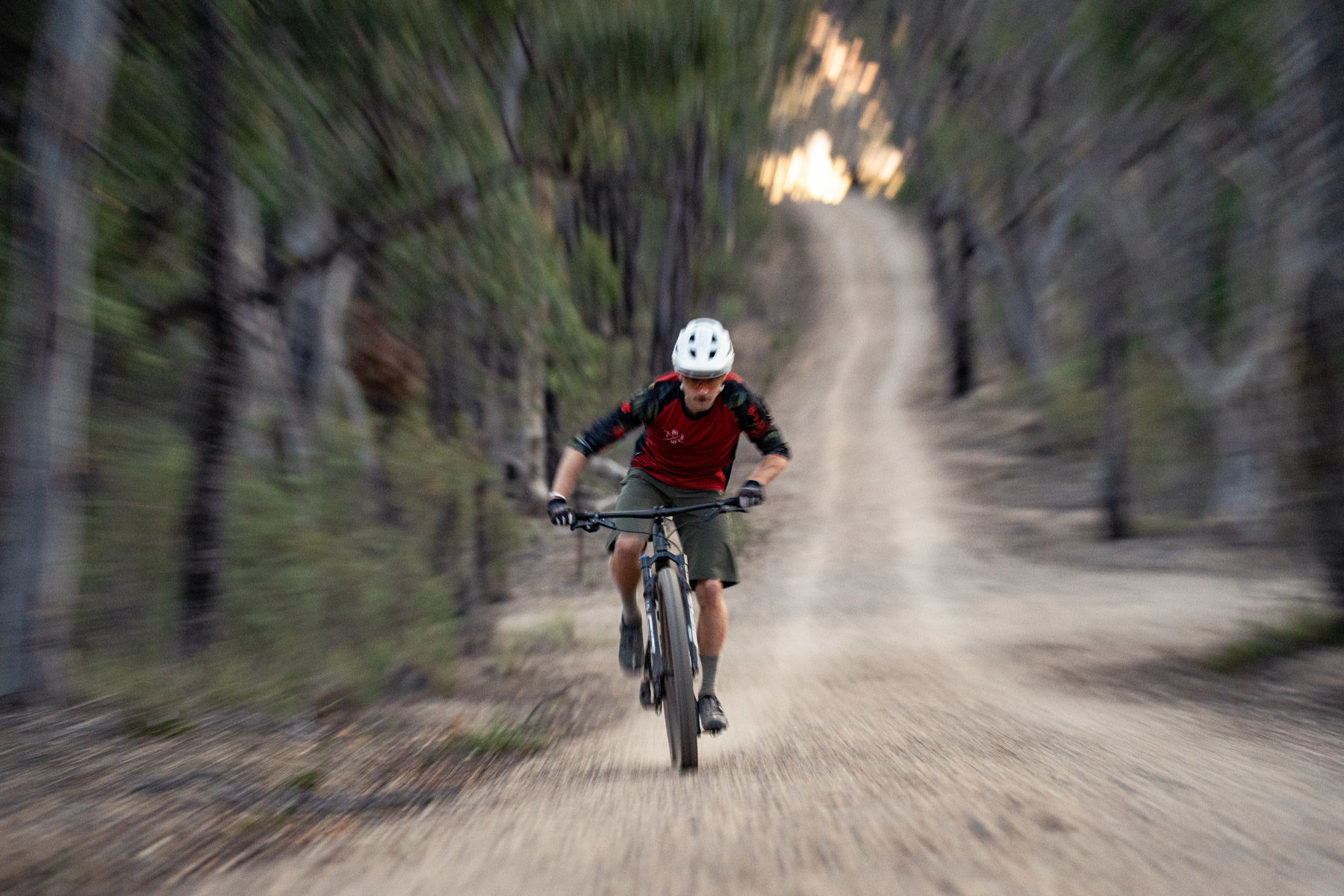
Still, the beauty about the Brain’s efficiency is that you don’t have to do anything, because it’s fully automatic. For riders who are looking for every possible advantage on the race track, this is a good thing – even if it’s just from a psychological perspective. There’s obviously no remote system to worry about, so you never hit a descent with the suspension accidentally locked out. And let’s be honest, we’ve all been there. It also keeps the cockpit super clean. Thanks to the wireless AXS shifter, there are just two brake hoses coming off the bars – a stark difference to a Scott Spark or Canyon Lux.
The Brain still clunks though
When you do hit a big enough obstacle, the inertia valve dislodges and oil is sent rushing through the valve and into the IFP. It’s this rush of oil that creates a clunking or knocking sensation (a bit like when you turn a tap on and water rushes through an empty pipe), which can be felt through the bike’s contact points. On the new Epic, the sensation is no doubt the smoothest and quietest it’s ever been, but it’s still there. If you’ve not been able to get over the clunk in the past, then your opinion is likely to remain unchanged.
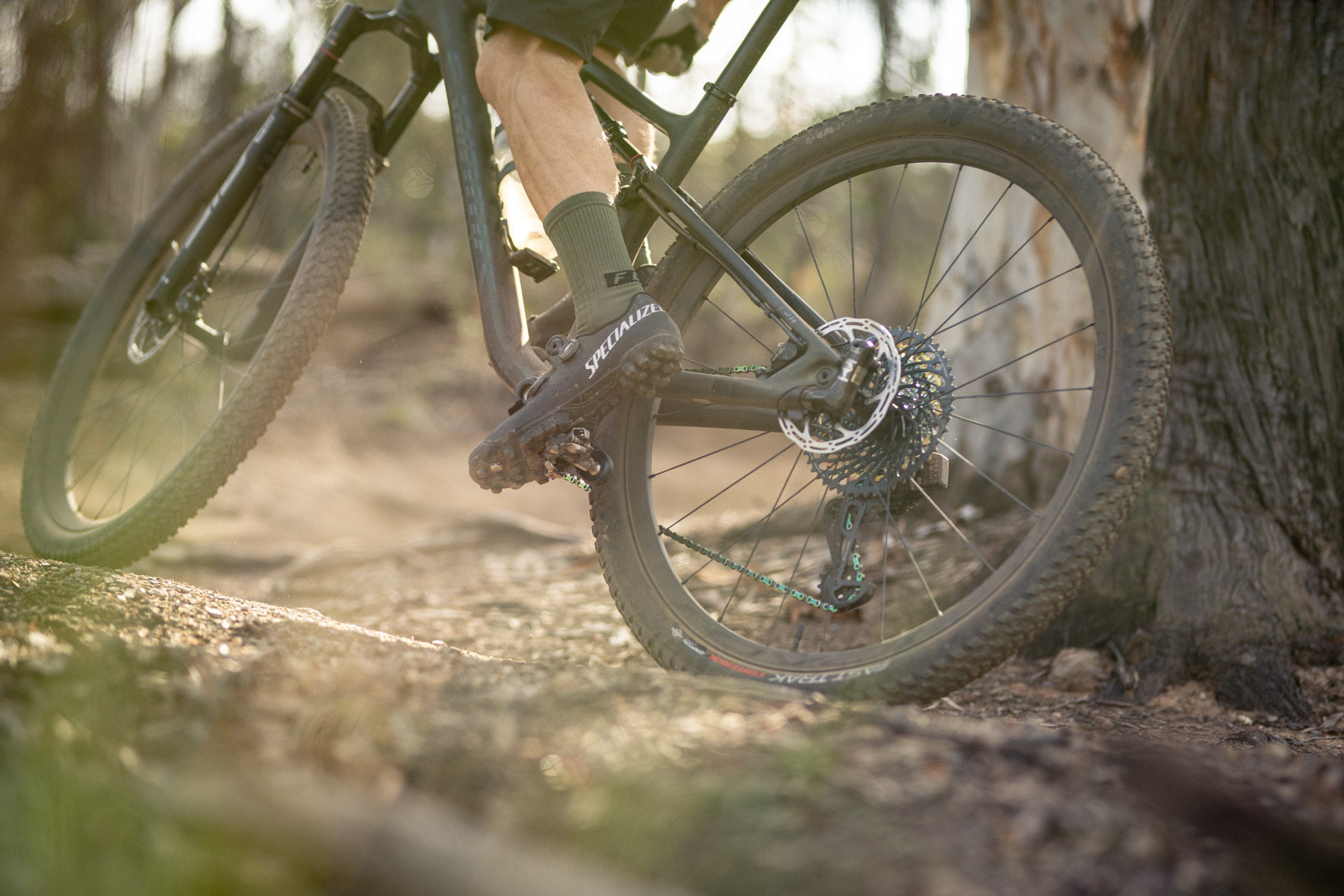
If you can get past it though, then there are obvious benefits to the design. It’s also worth noting that there is a bed-in period. We’ve put around 300km into our test bike, and the suspension has gotten smoother and more sensitive over that time. Once fully bedded in, there are no doubts that the Brain on this new Epic is the fastest reacting Brain so far. When you’re hammering across rocky, pedally singletrack, the suspension is remarkably proficient. It isn’t what I’d describe as plush, but it is effective. And the harder you ride it, the better it gets.
This is particularly the case for the fork, which requires a more assertive riding style to get the most out of it. When your weight isn’t on the front wheel though, the fork can lack sensitivity, as the valve is less likely to open. I found this to be the case when hitting bigger roots or rocky ledges on steep, technical climbs, where most of your body weight is on the rear wheel. In this scenario, the fork would remain locked, pushing more of the impact into your wrists. Certainly if you’re fatigued or having a bad day, it can be a fairly unrelenting bike to ride in general, unless you back the platform off entirely. Even then, it’ll still never feels as supple as the regular SID SL fork.

Otherwise, while descending or skipping across techy rock gardens, the suspension is thoroughly effective. On bigger hits, it’s also way more progressive than the previous Epic. I was never able to fully bottom out the fork, and while I used full travel on the shock, it was infrequent and never harsh. The increased progression to the rear suspension design means that when the valve is open (or you have the Brain Fade adjuster set to the softest position) the suspension performance is noticeably smoother and more active than prior Epics.
Epic handling
While the efficiency is certainly impressive, it’s the handling that has improved the most with the new Epic. Overall it’s vastly more calm and more stable, with very little of the twitchy nervousness that XC race bikes have suffered from in the past.
Much of this comes down to the slacker head angle and reduced-offset fork. The result is a much longer trail figure over the old Epic (106mm vs 94mm), which helps to dampen down the steering, particularly at high speed. I’ve felt way more comfortable staying off the brakes on rough descents, knowing that the front wheel is less likely to deflect. The fact that that you have more front centre beneath you also lessens the sensation of being pitched over the bars on the steep stuff. While that’s great for technical descending, it’s also useful on longer rides when fatigue kicks in, and mental concentration starts to wane.
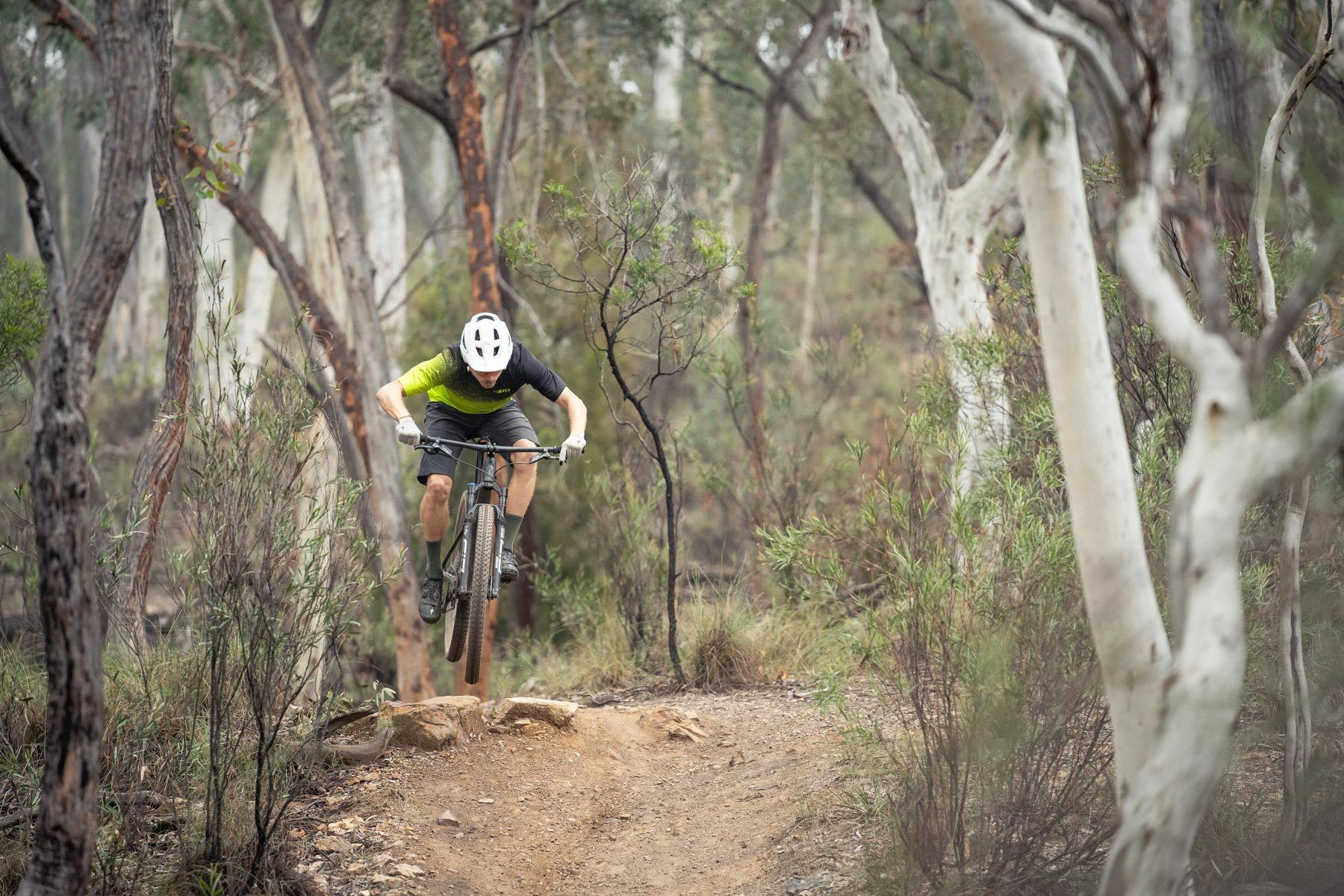
Logic would dictate that the added stability would come at the expense of agility elsewhere, and to a certain extent that’s true. On tighter off-camber corners, the new Epic can feel a touch more blunt in its approach if you’re coming from a sharper-angled bike. That said, it is something you adapt to within a couple of rides. On flatter corners, you simply need to lean the bike over more in order to initiate the turn. A dropper post would help in this regard, and I’d definitely be adding one if this were my bike.
Outside of awkwardly tight corners, the handling is better everywhere else. The steering is kept responsive thanks to the big bars and short stem, which as well as giving you a broad stance over the front of the bike, also maximises your torque over the front wheel. Combined with the stiffer and shorter back end, the Epic corners exceptionally well. The low weight keeps it responsive, and the low-slung chassis keeps your weight close to the ground to maximise grip.
Though the Brain suspension is most lauded for its efficiency, it also helps the Epic’s cornering by keeping the whole bike level. Dumping the front end into fast smoothly-banked berms, the fork doesn’t dive through its travel, ensuring that the head angle stays consistent. In these high-load scenarios, it tracks incredibly well.
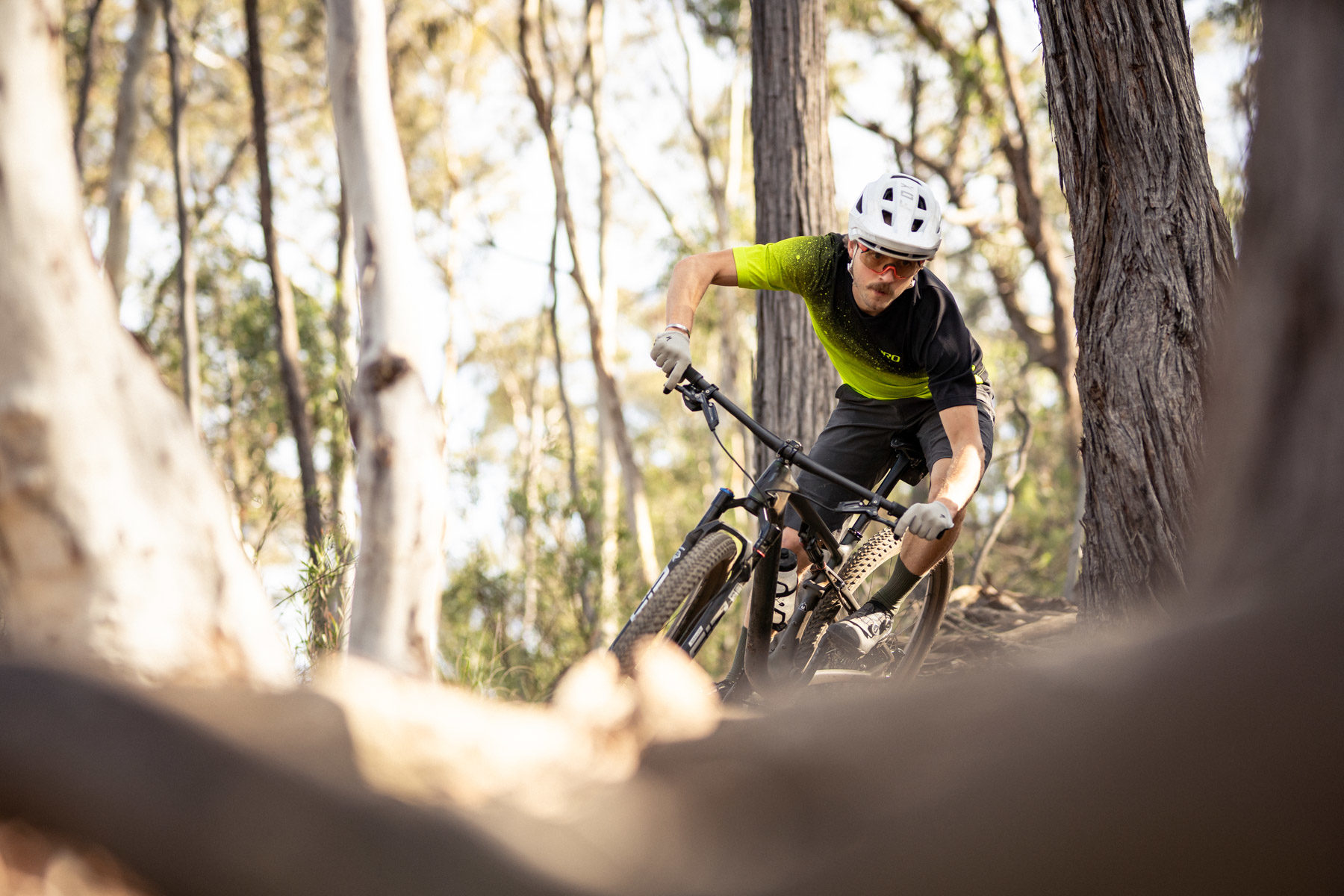

Component highs & lows
It would seem pretty difficult to find any weaknesses on a mountain bike that costs $19,000. And indeed aside from a dropper post, there really is bugger-all that you could upgrade on this ultra-premium S-Works model.
The fact that it comes with a power meter as standard will no doubt excite those who like to train with such things. Still, I’m a little puzzled why Specialized has spec’d a 32T chainring, and not a 34T that we’re more used to seeing on XC race bikes. For those with monster thighs, you’ll be happy to know you can run up to a 38T chainring on the new Epic.

Having used SRAM’s AXS shifting before, it didn’t take long to relearn the paddle shape and shift points. It is all very zippy, and I love how light the action is relative to a cable-activated system. That’s the sort of thing that’ll really shine when you’re deep into a big multi-day stage race, where even the smallest physical effort, like pushing a shift paddle, can feel like the hardest thing on earth.
Unfortunately the derailleur on our test bike started to go kooky after a month of riding though, which culminated in one particularly frustrating 3-hour ride where the inconsistent mech eventually just stopped working altogether. Upon closer inspection, it appeared that the derailleur’s limit screw hadn’t been setup correctly. While the mech was shifting ok for the most part, the lower limit screw was slightly too hard up against the stop on the derailleur body, which SRAM has informed us can actually burn out the motor over time. Aargh! And so the advice for an AXS mech is this: after initially setting the limit screws, SRAM recommends winding them off 1/4 of a turn to avoid this from happening, and all should be gravy.

The Roval Control SL wheels have been impressive so far, and are a genuine performance-booster on this bike thanks to their superb damping and zippy ride quality. The hubs come loaded with DT Swiss SINC ceramic bearings and the new Ratchet EXP freehub mechanism, with faster-engaging 54T ratchet plates for speedier pickup at the pedals. The broad rims also offer useful support for the 2.3in Fast Trak tyres, which I’ve always found a little floppy on narrower rims.
On the note of tyres, Specialized doesn’t recommend running anything any wider than 2.3in, but I’d say that’s being conservative. There is a load of clearance, which is something I discovered on some particularly muddy rides of late. You’ll also spot a neat rubber tunnel between the mainframe and chainstay yoke, which is there to shield the rear brake hose and derailleur cable (if you have one). The rubber grommet also helps to block rocks and debris from getting jammed up in that little nook. One thing I did notice though was how much mud can build up on the seatstay pivots. Given there are bushings and not bearings in there, I’d be conscious of checking those periodically.
One thing I did notice though was how much mud can build up on the seatstay pivots. Given there are bushings and not bearings in there, I’d be conscious of checking those periodically.
Otherwise the frame is clearly engineered to an incredibly high level, evident in the striking ‘Color Run’ finish. This is a technique whereby the painters take pigment in the raw powder form, rub it onto the raw frame with a glove (presumably while Enya plays in the background), before the clear coat is applied over the top. Not only is it super light (conventional paint can add up to 200g to a frame), it also means that every frame is unique, which you kind of want if you’re paying this kind of money. It’s kind of a moot point for us Aussies though, as we’ve been told that this colour won’t be coming to Australia, which is a real shame.

Is it really worth $20,100?
A most excellent question. We deliberately don’t delve too much into price in our reviews here at Flow, because ultimately it’s up to you as to determine what is good value, and what isn’t. And as someone on a bicycle journalist’s wage, I’m honestly the last person you want to ask about whether a bike is worth $20,100.
But there is no denying that this is a vast sum of money for a mountain bike, particularly one that doesn’t have a mid-mounted engine. We’ve seen some pretty big price tags over the past 12 months (for any proof, here’s a list of the most expensive production mountain bikes currently on the market), but even still we were shocked to see the RRP for this S-Works Epic.
Even while using RRPs, I was still able to build my virtual S-Works Epic for a good chunk less. My advice for those who want the S-Works model? Buy the frameset and build your own.
Given that Specialized is bringing the S-Works frameset into Australia, I decided to see what the price would come out to if I built the same bike from scratch. Even while using RRPs, I was still able to spec out my virtual S-Works Epic for less. Like, a good chunk less. My advice for those who want the S-Works model? Buy the frameset and build your own.
It does make the Epic Pro, the next model down, look like a comparative bargain. You could buy that bike, a dropper post, and the $3,400 Roval Control SLs as a secondary race wheelset, and still have change left over for an entry to the Cape to Cape.

Specialized Epic vs Epic EVO
The other big question you might have around the Epic is how it compares to the new Epic EVO. You can get the full rundown on the new EVO in our review here, but in a nutshell, it’s a Brain-less Epic with a bit more travel. The two bikes share the same mainframe, though the back end is slightly different. The EVO gets 110mm of rear travel via a conventional RockShox SIDLuxe shock, and it balances that with a 120mm SID up front. Geometry kicks back accordingly, and you also get a dropper post, a shorter stem, a burlier front tyre and more powerful 4-piston disc brakes.
In summary, the EVO is a smoother, poppier, more comfortable and more confidence-inspiring bike to ride. It’s still an XC bike, and it’s still efficient, but it doesn’t have that firm sprinting platform that the regular Epic has. I’d happily race on the EVO, but whereas the Epic is the uncompromising short-track speed freak, the EVO is more of a long distance mule. Think 100km marathons and multi-day events where comfort and control become more important. Certainly for mere mortals who aren’t racing at a national or World Cup level, the EVO will be the more practical, and more versatile option of the two.
If you’d like to know more about how the two bikes compare, be sure to check out our video review of the new Epic and Epic EVO.
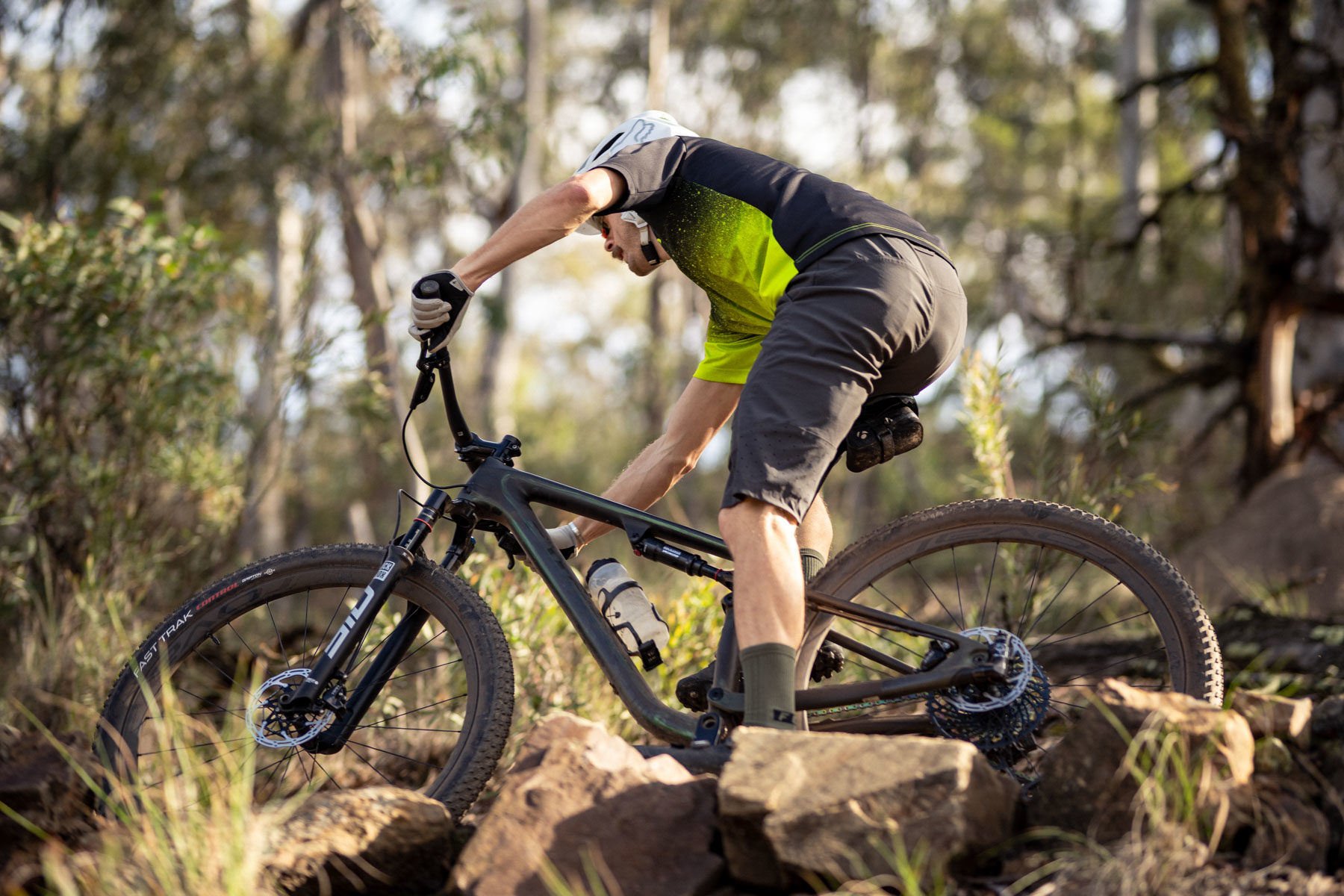
Flow’s Verdict
The Specialized Epic has always been known for its efficient pedalling manners, and this new version builds on that reputation with a firmer Brain platform that is smoother, quieter and more responsive than ever before. There’s still more feedback compared to bikes that utilise a more conventional suspension design, and that can make it pretty unforgiving unless you’re pushing hard. If your priority is efficiency though, and you can get your head around the clunking sensation, you’ll be rewarded with a powerful pedalling platform, ripping performance through the turns, and one of the cleanest setups going.
It’s the Epic’s handling that has really stepped up though, with a significantly more contemporary riding position and front-end geometry helping to boost the bikes’ competence on rough terrain and steep descents. And that makes it a significantly better bike compared to its predecessor. Along with the high-tech build kit and Brain-equipped suspension, there are no doubts this isn’t just the most expensive XC bike we’ve ever tested, it’s also one of the lightest and fastest too.
Keen to read more about the EVO? Check out our detailed review of the new Epic EVO here. And as always, be sure to tell us your thoughts in the comments below!





















